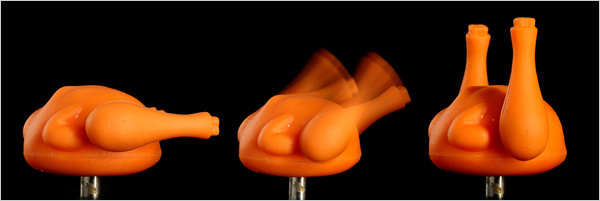Is today Thanksgiving in Canada, or is it tomorrow? Either way, Monday’s a holiday up there, bring on the turkey and side dishes.
But questions remain: what is the safest way to cook a turkey or  chicken?
chicken?
Thawing and preparing the bird to minimize cross-contamination present their own microbiological issues. Today, however, the big, really big news is that the Canadian government has spoken: poultry should be cooked to an end-temperature of 82C of 180F, not the 85C or 185F previously recommended (maybe they’ll change the advice). The U.S. says 165F or 74C.
I’m not so concerned about the specifics – there are lots of microbiologists who can make those arguments. I am concerned about taxpayer-funded public health organizations and rather spectacular failings in accountability.
For those who want to follow the British advice and cook their birds until they are piping hot, I refer you to Martin Mull’s History of White People, where it was concluded, “You can’t overcook turkey. That’s what the gravy is for.”
Color is also a lousy indicator. The only way to tell a bird has reached a microbiologically temperature is using a tip-sensitive digital thermometer. But at what temperature is poultry microbiologically safe? Should I make extra gravy?
Health Canada and government agencies in many countries issue all kinds of consumer advice: don’t smoke; wear condoms (but don’t flush them down the toilet); floss.
There are reams of consumer food safety advice, but sometimes, the PhDs from different countries disagree on the recommendation. That’s normal, scientists disagree all the time. But to ensure confidence in those consumer recommendations, it’s best to have a process that says,  “Look, you may not agree with what we decided, but here’s how we came to that conclusion, and here are the assumptions we made, so you take a shot at it and see if you can do better.” That’s the fancy way to describe the role of value assumptions in risk assessments and overall risk analysis.
“Look, you may not agree with what we decided, but here’s how we came to that conclusion, and here are the assumptions we made, so you take a shot at it and see if you can do better.” That’s the fancy way to describe the role of value assumptions in risk assessments and overall risk analysis.
For over a decade I have been politely asking Health Canada how they determine consumer recommendations for preparing poultry. What is the best way to thaw poultry? How do they determine the safe end-point internal temperature? What references do they use? (This discussion is specific to consumer practices in the home, not in food service).
I’ve never received an answer.
At one point I was less polite, and wrote a piece entitled, Health Canada pulls holiday recommendations from its ass. One of my favorites.
Either Health Canada media and science types I talked to didn’t know, or weren’t telling.
The process inspired no confidence.
In the U.S. in 2006, the recommended end-point cooking temperature for all poultry was lowered to 165F from the previous 180F. This was based on recommendations by the National Advisory Committee on Microbiological Criteria for Foods. Where the 180F recommendation came from , no one really knows. Diane Van, manager of the U.S. Dept. of Agriculture Meat and Poultry Hotline, was quoted as saying in a Nov.  2006 L.A. Times story about the old 180F advice, "I’ve looked all over and I really have no idea. I think it happened sometime back in the 1980s, but I don’t know what it was based on."
2006 L.A. Times story about the old 180F advice, "I’ve looked all over and I really have no idea. I think it happened sometime back in the 1980s, but I don’t know what it was based on."
At least that’s honest.
In Canada, the Health Canada recommendation for whole poultry is 185F. How was that temperature decided? Are there peer-reviewed journal articles that were used to develop that recommendation? Do bacteria behave differently north of the 49th parallel?
Given such inconsistencies, and the utter lack of accountability, why would consumers be expected to blindly follow what some governmental agency proclaims?
On Thursday, Oct. 7, 2010, seven Health Canada types had a paper published in the journal, Food Protection Trends, outlining Health Canada’s recommendation for the safe endpoint temperature when cooking whole raw poultry. The abstract is at the end of this post.
The curtain has been pulled back. Being in Kansas, I could use some Wizard of Oz metaphors, but won’t. And I wouldn’t say the three studies were “recently performed” as they were conducted in 2003-2007, 2000, and 1994.
Now, what is the process within Health Canada to translate scientific evidence into public policy recommendations? I expect that answer in another 10 years.
Safe endpoint temperature for cooking whole raw poultry: Health Canada recommendation
01.oct.10
Food ProtectionTrends,Vol.30, No.9, Pages 580–587
Gosia K. Kozak, Helene Couture, Thomas Gleeson, Kim Hopkins, Pauiett Maikie, Thuy Phan and Jeffrey M. Farber
ABSTRACT
Poultry is a known carrier of Salmonella. however, it can be safely consumed when cooked to an appropriate internal temperature. The United States Department of agriculture and some Canadian provinces recommend 74°C, whereas health Canada currently recommends 85°C, as a safe internal temperature for cooking raw whole poultry, a difference that can potentially create consumer confusion. To address this, health  Canada evaluated three studies recently performed in Canada to examine the survival of Salmonella in raw inoculated whole poultry (stuffed and unstuffed whole chicken and turkey), at six different endpoint temperatures. It was found that 82°C was a safe endpoint cooking temperature for whole unstuffed and stuffed poultry. The studies found that variability exists between and within ovens, and that shorter cooking times typically resulted in positive Salmonella tests in poultry. The thickest part of the breast was determined to be the optimum location for temperature measurement, as it was the last to reach the desired endpoint temperature. Thigh readings were often inaccurate and difficult to perform. As a result of the evaluation of these studies, Health Canada will likely be recommending changing its endpoint temperature recommendation for raw whole poultry to 82C, as measured in the thickest part of the breast.
Canada evaluated three studies recently performed in Canada to examine the survival of Salmonella in raw inoculated whole poultry (stuffed and unstuffed whole chicken and turkey), at six different endpoint temperatures. It was found that 82°C was a safe endpoint cooking temperature for whole unstuffed and stuffed poultry. The studies found that variability exists between and within ovens, and that shorter cooking times typically resulted in positive Salmonella tests in poultry. The thickest part of the breast was determined to be the optimum location for temperature measurement, as it was the last to reach the desired endpoint temperature. Thigh readings were often inaccurate and difficult to perform. As a result of the evaluation of these studies, Health Canada will likely be recommending changing its endpoint temperature recommendation for raw whole poultry to 82C, as measured in the thickest part of the breast.
 (Poor Canadians, still told to cook to 185F, but that may change to 180F; that’s what the gravy is for.)
(Poor Canadians, still told to cook to 185F, but that may change to 180F; that’s what the gravy is for.)
 possible foodborne illness outbreak associated with the Sacred Heart Turkey Dinner that was held on the evening of November 8.
possible foodborne illness outbreak associated with the Sacred Heart Turkey Dinner that was held on the evening of November 8. 
 chicken?
chicken? “Look, you may not agree with what we decided, but here’s how we came to that conclusion, and here are the assumptions we made, so you take a shot at it and see if you can do better.” That’s the fancy way to describe the role of value assumptions in risk assessments and overall risk analysis.
“Look, you may not agree with what we decided, but here’s how we came to that conclusion, and here are the assumptions we made, so you take a shot at it and see if you can do better.” That’s the fancy way to describe the role of value assumptions in risk assessments and overall risk analysis. meat was contaminated.
meat was contaminated. I literally just got home from one of my favorite casual dining restaurants here in Olathe. I ordered my favorite sandwich — the Avocado Turkey Burger. The server took my order first as my girlfriend was still deciding what to order. She ordered a different turkey burger (copy cat). As the server wrote her order down I jokingly called my girlfriend a "Copy Cat" out loud at the table for ordering the same (almost the same) sandwich. So to be different, I told the server "Hey, can I get my turkey burger medium rare"….she said "sure no problem sir", took her pad back out, wrote it down and walked off. I called her back to the table to explain I was just joking and that turkey had to be cooked "all the way."
I literally just got home from one of my favorite casual dining restaurants here in Olathe. I ordered my favorite sandwich — the Avocado Turkey Burger. The server took my order first as my girlfriend was still deciding what to order. She ordered a different turkey burger (copy cat). As the server wrote her order down I jokingly called my girlfriend a "Copy Cat" out loud at the table for ordering the same (almost the same) sandwich. So to be different, I told the server "Hey, can I get my turkey burger medium rare"….she said "sure no problem sir", took her pad back out, wrote it down and walked off. I called her back to the table to explain I was just joking and that turkey had to be cooked "all the way."  Is that like fight the power? Fight the man? Fight for your right to party?
Is that like fight the power? Fight the man? Fight for your right to party?.jpg) “
“.jpg) “Partially defrosted turkeys are another common festive food safety blunder.”
“Partially defrosted turkeys are another common festive food safety blunder.”.jpg) But Deputy County Executive Officer Kim Carpenter of Bloomfield, New Mexico,
But Deputy County Executive Officer Kim Carpenter of Bloomfield, New Mexico,  In preparing for Thanksgiving, President Bartlet calls the Butterball Turkey Talk Line for credible food safety information. This script had the president talking about cooking the stuffing to 165 degrees F, “If I cook it inside the turkey, is there a chance I could kill my guests? I’m not saying that’s necessarily a deal-breaker,” and admitting to owning an accurate thermometer. He raved about the ease of getting food safety information via a phone call – a wonderful, glowing endorsement for the professionals at Butterball.
In preparing for Thanksgiving, President Bartlet calls the Butterball Turkey Talk Line for credible food safety information. This script had the president talking about cooking the stuffing to 165 degrees F, “If I cook it inside the turkey, is there a chance I could kill my guests? I’m not saying that’s necessarily a deal-breaker,” and admitting to owning an accurate thermometer. He raved about the ease of getting food safety information via a phone call – a wonderful, glowing endorsement for the professionals at Butterball.